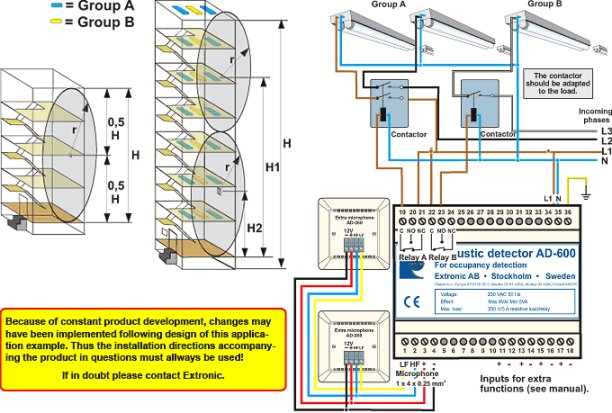4A. Stairwell with acoustic detector
50 Hz or non-dimmable HF operating devices
Svenskt patent nr. 9201493-5, English patent No. 0659329
| The premises
The stairwell is a closed area, access to which is through a number of doors. Acoustic technology is thus ideal in this situation, as it is the only technology that allows activation before entry into the area. Stairwells are often considered to be very frequently used areas, so consider the correct fittings and the correct method of control. Detection using the correct system is not generally a problem, but it is important to consider the correct way of controlling the light sources. A mistake in this context can have unexpected consequences involving greatly increased maintenance and wear on both light sources and operating devices. With new buildings or renovations we recommends that Dynamic Lighting control be installed (see application example 4B, which describes Dynamic Lighting control in stairwells!). Light sources This application shows an example of fittings with 50 Hz choke devices or non-dimmable HF operating devices. With conventional operating devices (choke operation), electronic activators (e.g. AURA Strike) must be used to reduce wear on the fluorescent tubes. Positioning of detectors Positioning of detectors and microphones with up to twice the radius between them is shown in the example below. The microphone’s range is a radius of 20 – 25 m, depending on acoustic conditions. Ceilings provided with acoustic plates can reduce the range of the HF signal. EKKX 1 x 4 x 0.25 mm2 can be used for connection of the microphones, which are connected in parallel. |
Control system
This example shows a conventional installation with acoustic detector, two lighting groups and adapting function. In the example it is recommended that the load be divided into two groups of two phases and one phase respectively, controlled by the acoustic detector’s ‘A’ and ‘B’ channel. Group A includes most fittings, and Group B a small number of fittings that meet the requirement for basic light. Upon deactivation, two phases (Group A) are broken first after a time delay set in accordance with the light-source manufacturer’s recommendations (often 10 – 20 minutes). If no detection takes place within two hours (e.g. at night), the third phase (Group B) is deactivated. This means the system has an adapting function that adapts to actual movements in the stairwell. Thus the stairwell is not dark during those periods of day when there are relatively frequent movements at least Group B is switched on. When the lighting is completely switched off or only Group B is switched on and someone enters the stairwell (a door opens), both lighting groups are immediately activated. For adjustment and programming of the acoustic detector, please see the detector manual.
Information for current budget
|
||||||||||||||
 |
|||||||||||||||





